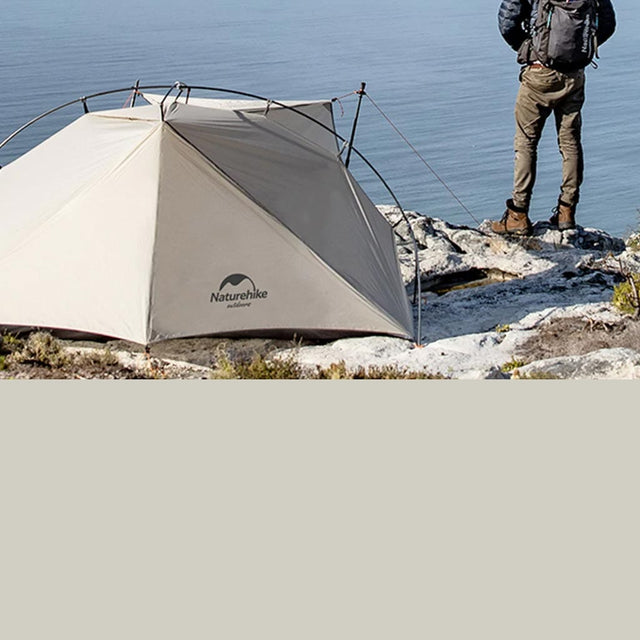Ultimate Guide to Choosing the Perfect Tent – Tech Specs Explained
When planning your next outdoor adventure, selecting the right tent is crucial; however, you must be asking yourself,
“Where do I start? What do all the specifications mean? How do I know whether the tent is suited for my trip?”
There’s no need to shop for Everest if you’re fishing in Dullstroom this weekend, just as much as you shouldn’t under-prepare if your trip is more strenuous.
At Naturehike, we want you to enjoy the outdoors as much as we do. This guide explains what all these technical specifications mean to help you make an informed decision.
Understanding Tent Dimensions
When browsing our product pages, you’ll notice two sets of dimensions:
Dimensions
This refers to the size of the tent when fully set up. For example, a 3-person tent measures 1630 x (2000 + 1100) x 1200mm, offering ample space for sleeping and gear storage.
Packed Dimensions
This indicates how compact tents become for transport. The 3-person tent packs down to 540 x ø170mm, making it easy to carry on hiking trips.
Always consider both dimensions to ensure the tent fits your group size and backpack - especially if you’re leaving the bakkie behind and hiking to your spot.
Weight Matters
Weight is a key factor for tents, especially for hikers and backpackers. Both our hiking tents and camping tents are designed to weather the elements whilst being conscious of how they travel:
-
2-person Tent: Great for two campers. The specific weight details vary by model, but options like the Cloud Up 2-Person tent weigh approximately 1.8kg., making it perfect for backpacking and hiking.
-
3-Person Tent: Designed for three people, this tent provides extra room without significantly increasing the weight. The Cloud Up 3 Ultralight 3P Tent tent weighs about 2.4kg.
-
4-Person Tent: Perfect for families or groups of four, this tent provides ample pace. The P Series 4P Tent weighs 2.8kg (including accessories), and is ideal for car camping or family trips.
Choose a tent that aligns with your activity level and carrying capacity.
Waterproof Ratings Explained
A tent's waterproof rating, measured in millimetres (mm), indicates how well the fabric can withstand water pressure before leaking.
This measurement is known as the hydrostatic head. For example, a fabric with a 2,000mm rating can endure a 2-meter (6.5 feet) column of water pressing down on it without leaking.
Higher numbers signify better waterproofing. Generally, a 1,000mm to 1,500mm rating is suitable for light rain, while ratings above 3,000mm are designed for heavy rain and more extreme conditions.
Tent Components Explained
-
Flysheet (Outer Layer): The tent's external layer acts as the primary shield against rain and wind. It's typically made from durable, waterproof materials like polyester or nylon.
-
Inner Tent: The inner tent is located beneath the flysheet and serves as the living or sleeping area. It's often constructed from breathable fabrics to promote airflow and reduce condensation.
-
Tent Floor (Groundsheet): This is the tent's base, designed to prevent moisture from seeping in from the ground. Materials like polyester or nylon with waterproof coatings are commonly used to enhance durability and water resistance.
Materials for Durability and Comfort
The materials used in our tents are chosen for their sturdiness, weather resistance and breathability:
-
Flysheet: 20D nylon coated silicone or 50D 290T polyester for lightweight strength.
-
Inner Tent: B3 breathable mesh and 20D nylon coated silicone or 240T polyester pongee for ventilation and comfort.
-
Base Layer: 20D nylon-coated silicone or 150D plain polyester Oxford cloth for added durability.
-
Accessories: Aluminium buckles, pegs, and poles result in stability and longevity.
Features for Enhanced Outdoor Living
Naturehike tents come packed with features to elevate your camping experience:
-
Ventilation: Excellent airflow to prevent condensation.
-
UV Protection: UPF50+ rating to shield you from harmful sun rays.
-
Versatile Setup: Options like one room, one vestibule, double vestibules or large vestibule modes for added convenience.
Which Tent is Right For You?
Planning a camping trip but feeling overwhelmed by all the tent options? We get it. That’s why we’re breaking down the different types of tents and helping you figure out which one suits your adventure.
Camping Tents
These tents are mainly for basecamp setups because they offer more interior and storage space. They’re usually heavier than other tents, but their sturdiness makes them perfect for family trips or extended stays at campsites.
Ratings to check: Waterproof rating and dimensions
Hiking Tents
As the name suggests, these are built for hikers and other adventurers who need a lightweight, compact shelter. They’re designed for quick setup and easy transport.
Ratings to check: Packed dimensions (portability) and waterproof rating (for unexpected weather).
Glamping Tents
Glamping tents are the “it girls” and “mancaves” of tents. They are spacious and made of high-quality material, so you can camp comfortably in a home away from home. While they’re convenient, they’re not built for extreme weather.
Ratings to check: Dimensions, fabric quality, and waterproof capabilities.
Pop-Up tents
These tents are your go-to if you want something hassle-free to set up. They’re a favourite for casual campers and festival-goers.
Ratings to check: Waterproof rating and dimensions to make sure it fits your needs.
Find Your Perfect Tent with Naturehike
Choosing the right tent doesn’t have to be complicated. By understanding weight, dimensions, waterproof ratings, and materials, you can confidently select the perfect shelter for your outdoor adventures.
With options to suit every price point, Naturehike ensures quality and affordability. Shop our tent collection today and gear up for your next trip.
Payment Options for Your Convenience
At Naturehike, we make shopping easy with flexible payment options, including Visa, Mastercard, Mobicred, Payflex, and EFT.
Naturehike – Your Partner in Outdoor Comfort.



0 Comments
There are no comments for this article. Be the first one to leave a message!